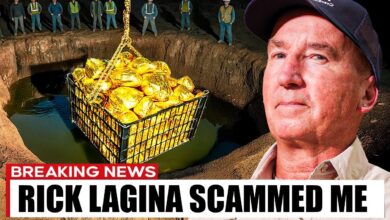The Curse of Oak Island: ANCIENT REMAINS Finally Uncovered (Season 10)
The Curse of Oak Island: ANCIENT REMAINS Finally Uncovered (Season 10)

Hello, you can see the area where it’s been cleared out. Yeah, Gary Drayton and Jack Begley returned to lot 32 west of the swamp. All the targets are all in there. You can see all the flags from here to continue searching for additional clues and valuables related to the remains of a possible ancient wharf that the team has found nearby.
So, let’s see what these targets are. Mine, I’m hoping for something good.
Okay, first flag’s over here, mate. When a lot is cleared, I usually go in first and I flag the area, meaning I do a methodical grid search pattern of the lot.
Just there, mate. And then I go in with Jack and we dig all the flags. You never know what’s going to come out of your next hole. I’ll try pinpointing it and then grabbing it out.
That’s a piece of something that could be interesting. It’s got a curve on it, so it could be like a barrel loop.
You think it’s connected to the wharf somehow? If it was a barrel loop, for sure. A possible barrel hoop, and near an area where the team has previously found evidence of an ancient wharf, as well as a French cargo bag seal.
If Gary is correct that he and Jack have just found part of a cargo barrel, just what kind of cargo might it have once contained? I would imagine that’s just the type of thing that would have been unloaded and pushed or barrelled. Everything was in barrels back in the days—nails, coins, yeah, so we’ll bag it.
It’s a vine, that’s interesting. It goes to Carmen Legg, so I’m hoping Carmen Legg can shed some light on what size barrel this is, because the smaller the barrel, the more chance to add treasure in it.
Hello, mate, that’s that bagged. Next flag’s here. Let’s see what this is, mate. You’re a beast.
See if you’re in the right area.
Do you think it’s more that way? Yep, I do. Let’s see.
[Music]
Just there, mate, isn’t that base of that wall there?
Damn, you’re gripping some gravy now.
Oh, there we go. Can you feel it? I think this is it right here.
Yeah, geez, careful, mate, there we go.
I thought it was a spike. Yeah, I think this was made like that on purpose. See all the square shank on it? I think this is some kind of tool. It might be some kind of chopping tool, like a small scythe.
Oh yeah. A possible scythe found on lot 32. Such tools have been used for agricultural purposes for thousands of years. However, they were also known to be common tools on sailing vessels that ventured between Europe and North America between the 15th and 18th centuries.
What I like about this, mate, is the size of it. It’s something that could have been carried on the ship. If it is some kind of tool, remember, we’ve got a potential wharf here. Just the sort of thing that you would carry here on the boat, and you come ashore, you’re going to do stuff on an island, you would need a tool or an implement.
I do believe this came from somewhere else, mate, for sure. Any idea? Indeed, anytime you see a square-shanked fastener or tool, then you know you’re in pre-1800s.
The fact may predate the discovery of the Money Pit in 1795. If so, could it offer more evidence of a possible ancient wharf nearby, and perhaps be related to the lead cargo bag seal that is believed to be of French origin?
This is what we’re looking for in this area. Yeah, this could show that there’s some sort of a work area related to the wharf.
Yeah, I think we need to bag and tag that.
Yeah, oh for sure.
Later that afternoon, Carmen—hello there, how are you again? Good, Howard, how are you?
Rick Lagina, Craig Tester, and Jack Begley welcome blacksmithing expert Carmen Legg at the research center. He has returned to Oak Island in order to give his analysis of the believed scythe and other metal objects recently discovered on lot 32.
Gary and I have already recovered a lot of iron objects from lot 32, and these are just some of the odd objects that we hoped you could identify for us.
Oh, okay. I won’t preface it at all. What do you think about that? Also, do you have an idea what it might be?
No. No, besides a medieval golf club.
[Music]
Well, you can clearly see the firebase in that. So, it’s a very old iron object.
When I first looked at it, I thought it was a tool, but it’s not, because the band is fastened on the outside of the rim here, right? So, it’s not some type of circle or anything like that.
The only thing I can think of is this is a large barrel strap from cargo.
Oh, there’s a distinct shoulder here going from the rim down to the band or the strap. Again, if you had a big barrel, especially if it’s valuable materials, you would want some reinforcement around the top, and that’s what that could be.
That leaves so many possibilities. Yeah, I see two rivets or joints on here. Very interesting piece, isn’t it? I would have never guessed barrel to start. It’s impressive.
It’s the only thing I can think of.
Okay, so this piece was also found on lot 32.
Oh, is it?
Well, right away you can see that the curvature on the top is different than the curvature on the bottom. So, this is a hoop off a barrel.
Fairly wide, and you can see the curvature is quite large. You follow that curvature all the way around—huge, about 200 gallons.
Wow. Or the width of the strap, to me, it tells it was a wet barrel made, um, whiskey. But you’re looking at a strap of a 200-gallon cask.
180 gallons of whiskey—you got to keep the morale up somehow, yes.
Would your average person have a barrel this big? No. So, what type of use? Like, would this be a naval thing?
Yes, military. Why would you have such a large barrel over on lot 32? Could be a large provision barrel for a group of men.
Wow. Any dates that you can discern out of this?
Well, middle 1700s to the later 1700s—1740s, 1760s.
Oh, that’s actually really intriguing.
A second piece of a large cargo barrel, and found in the same area where the team has discovered evidence of a possible ship’s wharf, as well as a lead bag seal believed to be of French origin.
And uncovered more evidence connecting the Duke of Anjou’s mission to bury a vast treasure in 1746 to the Oak Island mystery.
We know that there is a lot of military-associated items found on the island. When Carmen suggested that this barrel could have been as old as 1740—well, 1740 is an aha date because that’s, of course, right around the time of the Duke of Anjou’s expedition.
Is it a possibility that it could be connected to some work on the island associated with that expedition? It’s possible, but we’ve always got to prove that.
That’s incredibly enlightening when you breathe life into these artifacts that, to us, are somewhat lifeless, and now it’s come alive.
Well, as always, we appreciate it.
Very good, thank you very much. I had a barrel of fun. Thank you. See you later. Take care.
[Music]








